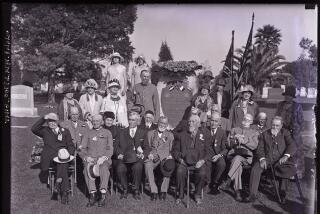Book Review: ‘The Last Stand: Custer, Sitting Bull, and the Battle of the Little Bighorn’ by Nathaniel Philbrick
Massachusetts-based author sifts through history for a closer look at the massacre of U.S. Army troops with Custer, Sitting Bull and the Battle of the Little Bighorn
The Last Stand
Custer, Sitting Bull, and the Battle of the Little Bighorn
Nathaniel Philbrick
Viking: 466 pp., $30
For many young and impressionable readers in the 1960s, there was an incisive and hilarious book, Thomas Berger’s “Little Big Man,” that did more than any other to replace the outdated narrative of the Old West as a contest between cowboys (good guys) and Indians (bad guys) with a reversal of roles, portraying European Americans as swashbuckling clods who committed genocide on the good-hearted natives.
George Armstrong Custer, once known as a brave maverick, came across as a deranged maniac in this new story. The battle of Little Bighorn, where Custer and his U.S. Army forces were famously massacred, was transformed from a noble “last stand” into an idiotic boondoggle. Director Arthur Penn’s movie version of “Little Big Man,” released in 1970 and starring Dustin Hoffman, gave this new perspective an even wider audience.
Nathaniel Philbrick, a Nantucket, Mass.-based historian and author of the maritime delights “Mayflower” and “In the Heart of the Sea” admits to having fallen under the sway of “Little Big Man,” as did countless others in our generation, believing it to be more accurate than the pap our parents were fed.
After writing about battles between Massachusetts settlers and natives at the close of “Mayflower,” Philbrick grew curious about the subsequent stages of that struggle, and he shifted his gaze two centuries later to the late 1800s, when the saga of Native Americans neared a tragic crescendo. The story of Custer and Little Bighorn, as an iconic myth at the core of the old civilized-against-heathen storyline and also as a supreme instance of white man’s folly in the “Little Big Man” version, seemed irresistible.
Philbrick set out to find out what really happened at Little Bighorn. It was not an easy task. Because Custer and every one of his officers and soldiers were killed, none could leave an account for posterity. Sioux warriors who were later interviewed by U.S. Army forces apparently “told their white inquisitors what they wanted to hear,” Philbrick notes. The author dug and sifted through previously private letters from soldiers, examined the ship logs on the riverboats that supplied Dakota territory, evaluated Custer’s colorful past and also studied the perspective of Sitting Bull, the Sioux chief who won at Little Bighorn.
“The Last Stand” is an engrossing, thoughtfully researched and tautly written account of a critical chapter in American history. With strong narrative skill, offering broad context and narrow detail, Philbrick recounts a story and, in the process, dismantles old myths piece by piece. Custer’s military action at Little Bighorn was certainly not the last stand of the white man, who soon succeeded in decimating the Indian population. There was not even a last stand by the hapless soldiers who followed Custer into what was clearly an ill-considered military action against a Sioux village on June 25, 1876, in what is now Montana. Instead, Custer’s final battle was messy, conflicted and confused. It did not signify anything heroic or deranged. Militarily, it was a blunder. To a historian, it was a telling incident that reveals much about the time.
Philbrick recounts how President Ulysses S. Grant, weighed down by corruption scandals in the final year of his presidency, did not have the political will to discipline the white miners whoflocked illegally into Dakota territory after gold was discovered there in the mid-1870s. It was Sioux-inhabited land and was, on paper, an independent nation. But for Grant, it was politically easier to chase out or even massacre Indians than to persuade the white miners to leave.
Grant knew Custer, who was widely recognized as one of the greatest cavalry officers who fought for the Union during the Civil War with distinguished service at Gettysburg. Charismatic, impatient, fearless in battle, Custer wore broad hats over the long blond ringlets that flowed down to his shoulders. He made brigadier general at age 23. He was also, Philbrick writes, a master manipulator of the media, aggressively wooing journalists as he plotted to run for president himself. Grant hated him.
While others in the Army wanted to use Custer’s military skill and bravado to chase away the Sioux from the gold-laden land, Grant ordered that Custer be tightly supervised by Gen. Alfred Terry, a lawyer whose insistence on careful planning and protocol drove Custer to distraction. Today, Custer might have been diagnosed as bipolar, or afflicted with ADD. He was recklessly impatient, known to bolt off suddenly on scouting missions, abandoning an entire regiment of soldiers who often had to stand on a hillside for hours, or days, until their commander returned.
The campaign against the Sioux and Cheyenne was described by U.S. authorities as an effort to defend innocent white pioneers from attack by Indians. But Philbrick shows persuasively that it was an unprovoked military invasion of a legally independent nation on land that only later, after the natives had been cleared out, became part of the United States. Philbrick’s version of history, while more serious and clear-eyed than “Little Big Man,” essentially embraces a similar perspective.
When Custer and his troops neared the Little Bighorn River, they could not clearly see the nearby encampment of around 8,000 Sioux and Cheyenne natives, roughly 40 times to 50 times larger than Custer had estimated. Two of Custer’s fellow commanders so distrusted him that one spent most of the day in a ditch with a bottle of whiskey, while the other waited on a hillside, doing nothing. Custer did not hesitate to attack.
The end was apparently quite swift. Screams and gunshots may have echoed across the plain, but none was heard by nearby U.S. forces, who only the next day discovered more than 200 bodies of fellow soldiers, including Custer’s, with a mysterious smile on his face. The battle soon became rich material for mythmakers, portraying a heroic fight between enlightenment and savagery. “Little Big Man” upended that view. “The Last Stand” buries it.
Faison is the author of “South of the Clouds: Exploring the Hidden Realms of China.”


